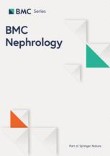A cohort study of membranous nephropathy, primary or secondary
BMC Nephrology volume 22, Article number: 138 (2021)
Abstract
Background:
Although IgG4 deposit against phospholipase A2 receptor (anti-PLA2R) is predominantly presented in the renal biopsy of patients with primary membranous nephropathy (MN), its diagnostic value of this immune complex has not been fully established.
Methods:
In this cohort study, 108 biopsy-proven MN patients with proteinuria were evaluated during two years follow up and were divided into primary and secondary groups. Renal biopsy specimens were pathologically assessed for IgG4 and PLA2R depositions by immunohistochemistry (IHC). Therefore, the relationships between staining severity, MN type and total proteinuria in all patients were determined.
Results:
Of 108 patients, 73.1% had primary MN and 26.9% were diagnosed as secondary form. IHC staining in patients with primary MN was positive for PLA2R in 76 (96.2%) and IgG4 in 68 (86.1%). Cases with positive PLA2R expression had a significantly higher rate among patients with mild to moderate stages (P = 0.03). No significant relationship was found between intensity of PLA2R and IgG4 deposits with proteinuria and serum creatinine. Based on our data, double positivity/negativity of PLA2R and IgG4 expression adds prominent information to the clinical data and were found to be useful and robust biomarkers for detection of primary MN patients with high sensitivity and specificity (97.1 and 96.3% respectively, PPV = 98.5% and NPV = 92.9%).
Conclusions:
Simultaneously expression of PLA2R and IgG4 in renal biopsy specimens of patients with MN could possibly be used as a potential diagnostic method to distinguish primary from secondary MN and also pathological severity of the disease.
Keywords:
Membranous nephropathy,Phospholipase A2 receptor ,PLA2R ,IgG4 ,Primary MN ,Secondary MN

